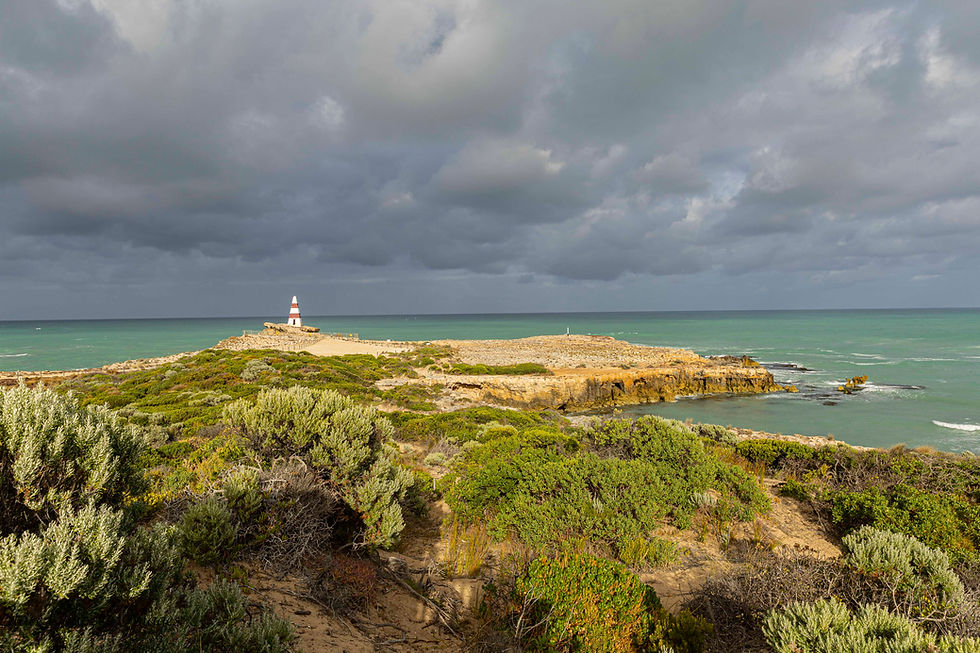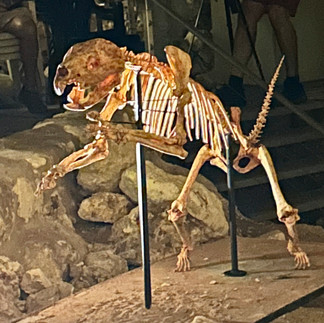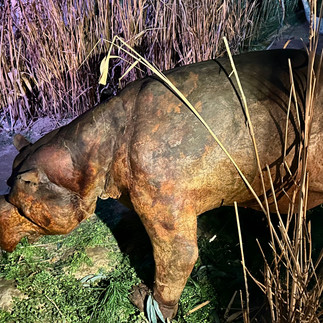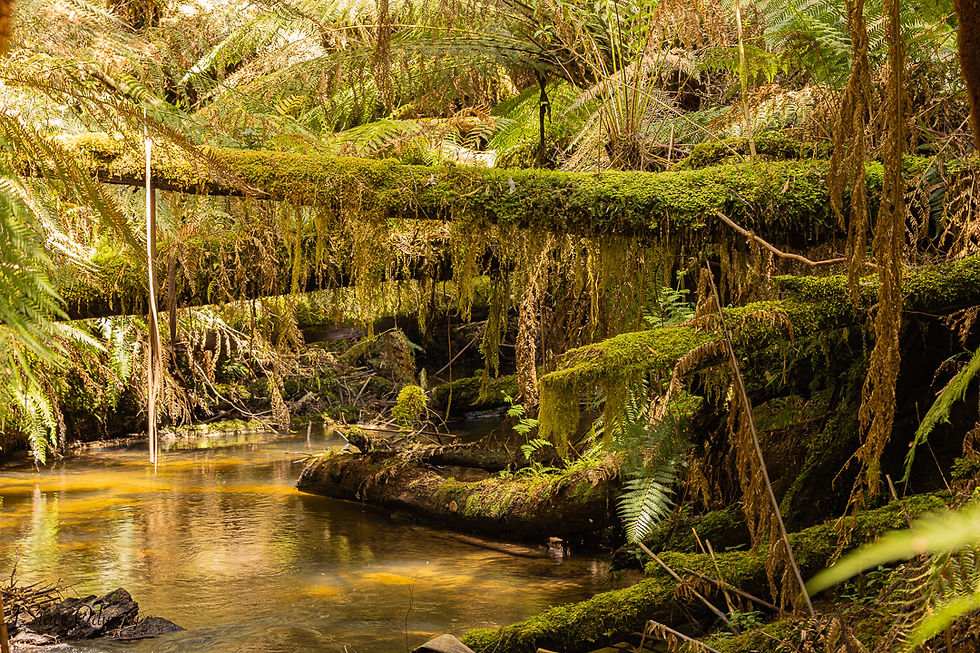Travelling the Limestone Coast: Nature's Masterpiece
- Lauretta Stace

- Mar 23
- 4 min read

Stunning beaches, fine white sand, sinkholes and caves, ancient wonders and salt lakes, the Limestone Coast, located in the southeastern corner of South Australia, is a spectacular destination. The region is renowned for its breathtaking landscapes, rich history, and diverse wildlife. Our Odyssey takes you through some of the highlights of this fabulous region as we make our way to Kangaroo Island, along with some good friends who are accompanying us on this part of our journey.
Coastal wonders
The coastline is dotted with beautiful beaches and rugged cliffs, perfect for outdoor activity and landscape photography. It's here that you can easily witness the constantly evolving landscape as the chalky imestone rocks are weathered away by wind and waves, leaving vast pools of turquoise water and fine, white sand beaches that glitter in the sunshine.
Robe
Our first stop was the lovely coastal village of Robe where we camped on the shore of Lake Fellmongery.
The town is named after a former Governor of South Australia, and it has an interesting indigenous and european history. For at least 30,000 years, the area was home to the Bunganditj and Meintangk peoples. whose population was sustained by rich local food sources such as shellfish. The town overlooks picturesque Guichen Bay, first charted in 1802 by French explorer Nicolas Baudin, as part of a major scientific expedition approved by Napoleon Bonaparte. It was largely settled by pastoralists in the mid-1800's and also became a major commercial fishing hotspot.
We spent our time exploring the local beaches and headlands as well as some tidal creeks and wetlands that are home to a large variety of water birds. It was fascinating to see the ruins of a 19th century gaol and try to imagine the experience of the inmates. The signature pyramid-shaped obelisk at Point Dombey was erected in 1855 as a marker for ships. The Doorway Rock is an obvious symbol of weathering and erosion by wave and wind action.
Our journey also took us through the Little Dip Conservation Park and past some vast salt lakes to the towns of Nora Creina and Beachport.
Birds of Robe
The area surrounding Robe contains a myriad of lakes and wetlands that drain into the sea, making it a haven for waterbirds. An excellent bird hide has been estalished on one of the tidal creeks which gave us ample opportunity to watch and photograph some special birds. The morning light was particularly good for catching reflections in the still water. A bonus sighting was the beautiful spotted crake. Crakes are generally quite shy, secretive and elusive, so difficult to find. See images below in Row 2.
Food, glorious food
The Limestone Coast is renown for its dining experiences, fresh produce and abundance of delectable seafood, including crayfish, and it did not disappoint. We had a terrific dinner and beverages at the historic Caledonian Inn, first licenced in 1858. We also enjoyed a magnificent feast of fresh oysters, prawns and crayfish from the local fishmonger. What a great start to the journey!
And of course, there's the famous giant crayfish at Kingston!
Natural ancient wonders
The Limestone Coast is famous for its unique geological formations and natural wonders. A highlight was the stunning caves of Naracoorte, A UNESCO World Heritage site, known for its fossil deposits and impressive limestone formations.
The Naracoorte Caves are part of the 800,000 year old Naracoorte East Range and are one of the world’s most important fossil sites for Australia's extinct megafauna. For half a million years the caves acted as pitfall traps and predator dens. Animals would fall in through a hole in the ground and not be able to escape. Bones collected – layer upon layer, year after year – creating a rich fossil record of the ancient animals that roamed the area. The fossil record covers several ice ages and the arrival of humans in the area. The fossil deposits preserve diverse vertebrate species, including more than 135 different examples of amphibians, reptiles, birds and mammals. Nearly 20 species of megafauna are preserved, including nine species of extinct kangaroos. The preservation of the fossils is exceptional.
Imagine finding yourself face-to-face with a 130kg marsupial lion, a 200kg wombat, a 5 metre python or an enormous kangaroo! It's not hard to do when you you see the bones, skeletons and replicas of these fascinating creatures at the caves. It was a wonderful journey through eons of time, when the continent was covered in rainforest and these giants roamed free. The reign of these amazing animals came to an end around 45,000 years ago, with the precise cause for their extinction still a hot topic for debate but likely to be climate related.
The Coorong
As we headed west, we took the road less travelled to journey through the Coorong National Park via the small town of Salt Creek. The Coorong National Park is a spectacular saline lagoon stretching 140km. It is separated from the Southern Ocean by sand dunes and windswept beaches of the Younghusband Peninsula, and is internationally significant under the Ramsar agreement as a migratory wader and waterfowl refuge.
The Coorong is ideal for birdwatching and photography with its distinctive landscape in an important breeding area for the Australian pelican and is a refuge for ducks, swans, cormorants, terns, grebes and around 230 migratory birds that travel annually from Siberia, Alaska, Japan and China. We were fortunate to see some red-capped plovers wading in the briney water whilst pelicans soared overhead.
Lake Albert - Meningie
Our final destination on this leg of the journey was the township of Meningie, perfectly situated on the vast expanse of Lake Albert. After arriving at our campsite, following a day of exploring the Coorong, it was a great to just sit and watch the pelicans playing as the sun faded away into the dusk. Sometimes, it's just nice to do nothing whilst enjoying the great outdoors and a well deserved glass of wine.
To see more about our journey along the Limestone Coast, watch our video on YouTube:
Next stop for the Stace Odyssey - Kangaroo Island!










































































































































Comments